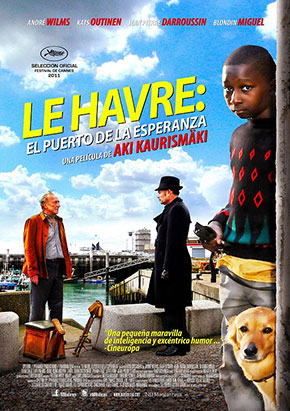
Baseball's Active Leaders, 2023
What Trump Said When About COVID
Recent Reviews
Everything Everywhere All at Once (2022)
Black Panther: Wakanda Forever (2022)
Doctor Strange in the Multiverse of Madness (2022)
Spider-Man: No Way Home (2021)
The Cagneys
A Midsummer Night's Dream (1935)
Something to Sing About (1937)
Angels with Dirty Faces (1938)
A Lion Is In the Streets (1953)
Man of a Thousand Faces (1957)
Never Steal Anything Small (1959)
Shake Hands With the Devil (1959)
Le Havre (2011)
WARNING: SPØILERS
Early in the French-Finnish film “Le Havre,” the main character, Marcel Marx (André Wilms), is sharing drinks with Yvette (Evelyne Didi ), the owner of “La Moderne,” a small neighborhood pub. He’s telling her about his wife, Arletty (Kati Outinen), who was recently diagnosed with cancer. It’s bad, this cancer, but Marcel doesn’t know that. Arletty convinced her doctor to tell him otherwise. So on this night, a free drink in hand, Marcel has some relief. “Benign,” he says of the cancer with a smile. “Completely benign.”
Those were my thoughts about “Le Havre.” The film is benign. Completely benign. Too benign.
Marcel, a handsome man in his 60s, ekes out a living as a shoeshine in the French port city of Le Havre. As the film opens, people flood out at a subway stop and past two shoeshines, Marcel and Chang (Quoc Dung Nguyen), who look down at everyone’s shoes, hoping for the dress variety but generally getting the sloppy shoes most of us wear. Then a shifty-eyed man in a suit, with dress shoes and a briefcase handcuffed to his wrist, arrives. He stops to get a shoeshine from Marcel, less because he wants one than as a distraction against those who are pursuing him. Doesn’t work. They gather. He sees them here ... and there. When he bolts, they follow. Most movies would follow as well, since most movies are about such things; but Finnish director Aki Kaurismäki (“The Man Without a Past”) stays on the men who shine shoes. He stays with the down-but-not-quite-out in this port city equidistant between Paris and London.
Marcel is a bit of rascal who steals bread, lets bills linger, but has the charm to get away with it. His wife awaits his return, then sends him off for an aperitif while she cooks, then shines his shoes while he sleeps. They keep what savings they have in a small tin box. The next day he does it again. It’s a hand-to-mouth existence, but, since this is France, what goes into the mouth is pretty good.
Meanwhile, a port nightwatchman making the rounds taps onto a large cargo container and hears a baby cry. Authorities are alerted, including Inspector Monet (Jean-Pierre Darroussin). They expect dead bodies but when the container is opened an entire west African family is nonchalantly living there, including Idrissa (Blondin Miguel), who, seeing his chance, stands, waits a bit, looks at an elder, who nods, then makes a dash, or a kind of half-jog to the front of the container, where he stops, confronted, or not, by three or four cops. They all stare at each other with blank expressions. Then Idrissa makes a dash, or a kind of half-jog, down a row of containers to safety. No one tries to stop him, although one cop pulls a gun and aims it before Inspector Monet tells him to put it away.
It’s a pivotal scene for content as much as tone. But what to make of the tone? Some might be amused by its purposeful inauthenticity. They might like the stiffness and amateurishness of it all. It might remind them of Wes Anderson x 10. Me, I saw little charm and less amusement.
These two characters, Idrissa and Marcel, cross paths, of course. As the newspapers splash scary headlines about the escaped youth, wondering if he has links to al Qaeda, Marcel shelters him. When the police close in, the neighborhood shelters Marcel. When $3,000 is needed to smuggle the kid to London, where his mother works in a Chinese laundry, Marcel convinces local rock star, and homunculus, “Little Bob” (Roberto Piazza), to throw a charity concert. The rest of the money Marcel pulls from the small tin box. When Inspector Monet figures out everything, he, too, turns out to be benign, and misdirects the other cops to allow Idrissa’s escape. The world’s a nice place. The common people—except for a nasty neighbor—stick together.
All of these good deeds do not go unrewarded, either. Yvette makes a recovery that astounds her doctors and returns home with Marcel. “Look Marcel,” she says. “The cherry tree blooms. I’ll make dinner right away.” The End.
“Le Havre” made me laugh a few times. I like the names, the homage, Kaurismäki chose for his characters. Marcel for Marceau or Carne? Marx for Groucho, Harpo or Karl? Arletty obviously for the great French actress. Yvette for Mimeux? Even Marcel’s dog, Laika, is named for the Russian dog who was shot into space in the 1950s, and whom Ingemar eulogizes throughout Lase Hallstrom’s great film, “My Life as a Dog.”
But the film does nothing for me. It feels fake in tone and fake in content and fake in lesson. What’s the point of it? It’s been called “Keatonesque,” after Buster, but Keaton was the deadpan comedian amid great turmoil, which he often unknowingly caused. Here, Marcel is the lively character, the charmer, amid a deadpan world. Can you celebrate life by staring at it blankly? I think not, but Kaurismäki seems to think so.
Fans of “The Man Without a Past” should know: I didn’t like that one, an Academy Award nominee for best foreign language film, either.
—December 9, 2011
© 2011 Erik Lundegaard







